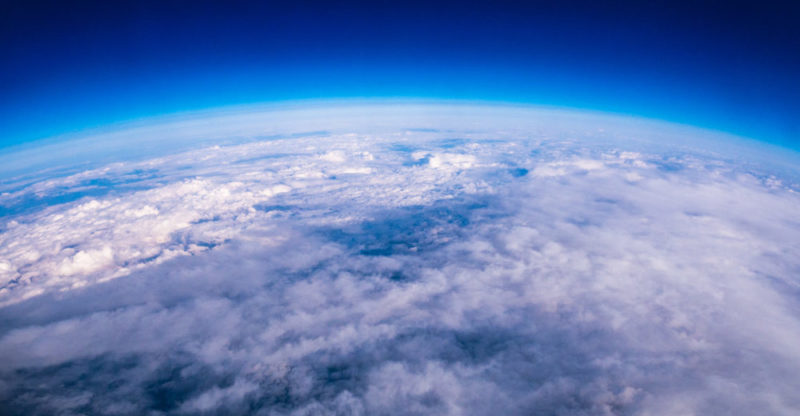What is the Atmosphere?
Atmosphere
We explain what the atmosphere is, where it is located and how it is composed. Also, what are its characteristics and contamination.

What is the Atmosphere?
The atmosphere is the different layers of gases that cover the celestial bodies , attracted by their gravity until they stabilize around them, reaching different heights. Its chemical composition can be varied and, in the case of our planet Earth , contains the air we breathe and the gases that allow the existence of life .
The Earth's atmosphere is known as the Earth's atmosphere and this article will focus on. The Earth's atmosphere is unique in its composition in the Solar System , as it contains the appropriate combination of gases important for life to take place on the planet's surface.
In the atmosphere , the conditions of temperature and pressure that allow the hydrological cycle exist , there is the ozone layer that shields the planet from solar radiation, and friction occurs that reduces the meteorites that come from space to dust .
Atmosphere location

The Earth's atmosphere is found around the planet's surface , extending from the ground up to 10,000 kilometers around the planet, in various layers of more or less uniform gases.
75% of its gaseous mass is located in the first 11 km of elevation from the sea surface , and as it gains height it also gains an important measure of pressure.
Composition of the atmosphere

The composition of the atmosphere has varied throughout the history of the planet, especially since the appearance of living beings , which consume certain gases and produce others. However, its composition is mainly nitrogen (78%) and oxygen (21%) , along with other important gases such as ozone, hydrogen , carbon dioxide, argon and other noble gases . It also contains a significant presence of water vapor (H 2 O).
Regions of the atmosphere
Two regions are commonly distinguished in the Earth's atmosphere, which are:
- Homosphere. Its name comes from its constant and regular composition, which occupies the first 100 km of the atmosphere from the ground. There are all the gases necessary for life in different proportions.
- Heterosphere. Its name comes from the fact that it is stratified in different layers of gases, which vary according to height and pressure:
- 80-400 kilometers high: molecular nitrogen (N 2 ).
- 400-1100 kilometers high: atomic oxygen (O).
- 1100-3500 kilometers high: helium (He).
- 3500-10,000 kilometers high: hydrogen (H).
Layers of the atmosphere

The Earth's atmosphere is usually divided into layers, which respond to its variation in temperature and pressure, thus forming a scale called the atmospheric thermal gradient. These layers would be:
- Troposphere. The lower layer, which goes from the first 6 to 20 kilometers high. It is the layer where climatic phenomena occur and the end of the layer is at a temperature of -50 ° C.
- Stratosphere. It ranges from 20 to 50 kilometers high, arranged in various strata or phases of air (hence its name). In it, the transformation of oxygen into ozone by ultraviolet rays takes place, a process that generates heat, which is why temperatures increase in this layer (-3 ° C).
- Ozonosphere. In reality it is a phase of the stratosphere, where the greatest amount of ozone is produced and, therefore, is the well-known ozone layer that protects the planet from the direct impact of the sun's rays, absorbing more than 95% thereof.
- Mesosphere. It extends between 50 and 80 kilometers high, and contains only 0.1% of the atmospheric air mass. It is the coldest area in the entire atmosphere: it reaches temperatures down to -80 ° C.
- Ionosphere. Also called thermosphere, it ranges from 90 to 800 kilometers in height, and in it the temperature increases with altitude, according to the presence of the solar rays. Temperatures of 1500 ° C and even higher have been recorded there.
- Exosphere. The outer layer of the atmosphere, which begins at 800 kilometers and ends at 10,000. There the atoms escape into space, and it is the transit zone between our planet and outer space.
Greenhouse effect

The greenhouse effect is known as the presence of atmospheric gases such as carbon dioxide that form a dense layer in the atmosphere and prevent the escape of terrestrial heat (similar to the walls of a greenhouse). This effect is vital for the preservation of terrestrial heat , essential for life.
Importance of the atmosphere
The atmosphere fulfills vital functions for the stability of the planet, as we have said. Not only does it allow the perpetuation of biochemical cycles by supplying the essential gases , but it also prevents heat leakage into outer space, it shields us against meteorites (friction with the air disintegrates them) and solar radiation. Without it, we would be exposed to the elements of space and dramatic variations in temperature between day and night.
Magnetósfera

The magnetosphere is the name given to the region of the atmosphere in which the planet's magnetic field is noticeable . This is generated by its rotational movement and by its cast iron heart , which acts like a dynamo. This field is also vital to prevent the entry of the solar wind and other forms of electromagnetic radiation to our planet. When this happens, the so-called "auroras" are produced.
Earth magnetism .
Space travels

Overcoming the resistance of the atmosphere is one of the main challenges of space travel, as well as overcoming gravity in a sustained way. The friction that a space shuttle undergoes during its takeoff in the initial layers of the atmosphere can cause heating, deviation of the trajectory and even breakage of materials. Instead, once in the outer layers, the low density of gaseous material will allow displacement in a much more gentle way.
Origin of the atmosphere
The origin of the atmosphere is usually attributed to the presence of gases originating in the early stages of the Solar System , which were trapped in the planet's gravity, as well as the degassing of the Earth's crust as it cooled. To this must be added the ice and water from the impact of comets on Earth and, then, the appearance of the gases typical of organic life.
Pollution of the atmosphere

Air pollution occurs mainly in the form of gases , which not only enhance the greenhouse effect but also corrode the ozone layer, allowing the entry of solar radiation and increasing the temperature of the planet. To this must be added the suspension of toxic particles in the lower layers of the atmosphere, which can lead to acid rain .
Update date: February 26, 2021.
Recommended Contents
Abstraction: What is it, Characteristics, Types
Floods » What is it, Characteristics, Concepts
Histology: What is it, History, Methods, Branches
Narrative text: What is it, Characteristics, Types
Roman Law › What is it, Characteristics, Sources, Periods
Sources of law › What is it, Characteristics, Examples
10 Characteristics of Autism
10 Characteristics of Autocracy
10 Characteristics of Birds